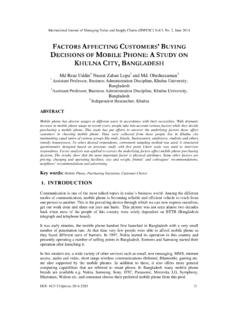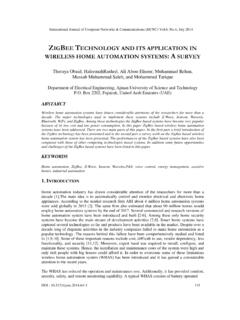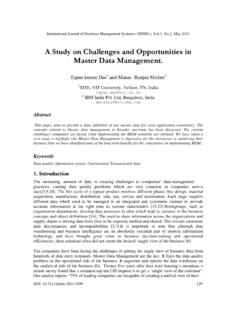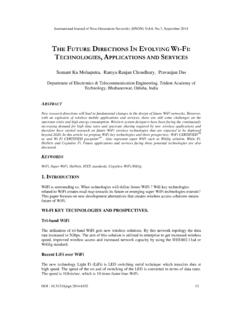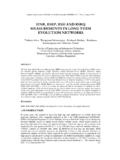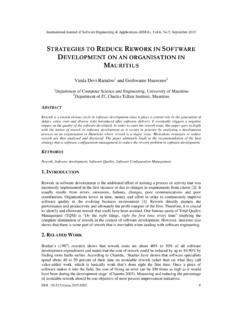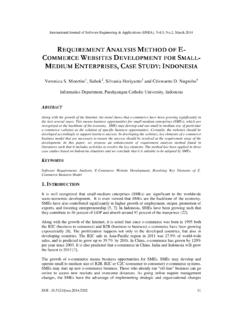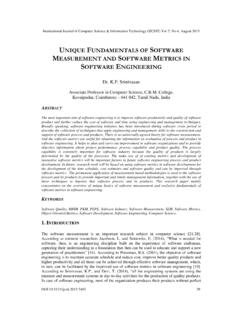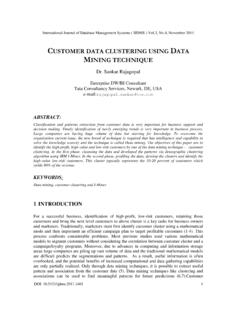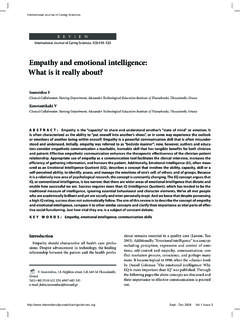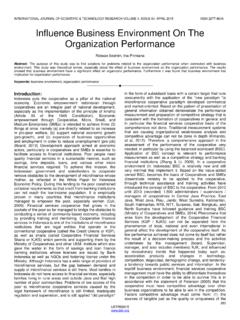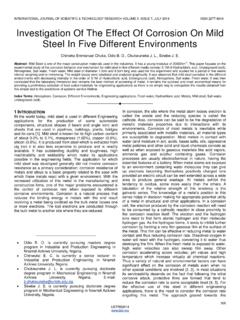Transcription of International Journal of Managing Value and …
1 International Journal of Managing Value and Supply Chains (IJMVSC) Vol. 3, No. 1, March 2012 DOI: 01 GREEN SUPPLY CHAIN MANAGEMENT: A REVIEW AND RESEARCH DIRECTION Noor Aslinda Abu Seman1, Norhayati Zakuan1, Ahmad Jusoh1 and Mohd Shoki Md Arif 1 Faculty of Management and Human Resource Development, Universiti Teknologi Malaysia, 81310, UTM Skudai Malaysia Muhamad Zameri Mat Saman2 2 Faculty of Mechanical, Universiti Teknologi Malaysia, 81310, UTM Skudai Malaysia ABSTRACT Green Supply Chain Management (GSCM) has appeared as an environmental innovation which integrates environmental concerns into supply chain management. GSCM has gained popularity with both academic and practitioners. The purpose of the paper is to briefly review the recent literatures of the GSCM and also determine the new direction area of this emerging field.
2 A detailed review is used to sort out the literature and develop the research direction of the study. The review is focused on development of GSCM in a developed and developing countries including all those researchers which is relevant to environmental and social sustainability towards operation management and the supply chain. It shows that lack researches to examine the adoption and implementation of GSCM practices especially in developing countries such as Malaysia. Thus, the authors bring forward a proposed research direction on GSCM adoption and implementation in Malaysia s manufacturing industries. KEYWORDS Supply Chain Management, Green Supply Chain Management, Environmental Management, ISO 14001 Certified Manufacturing Firms 1. INTRODUCTION The economic growth increases the level of energy and material consumption, which contribute to the environmental issues and resource depletion problems.
3 It has become increasingly significant for organizations facing competitive, regulatory, and community pressures to balance economic and environmental performance [1]. Nowadays, most organizations are starting to go green in their business as concern to environmental sustainability. They have realized the greater benefit of the green technology adoption in business operation, which also affected suppliers and customers. Environmental issues under legislation and directives from customer especially in the US, the European Union (EU), and Japan become an important concern for manufacturers [2]. As a result, Green Supply Chain Management (GSCM) emerges as a new systematic environmental approach in supply chain management and has been increasingly accepted and practices by forward-thinking organization [3]. The current changing in environmental requirements that influenced manufacturing activities had increased attention in developing environmental management (EM) strategies for the supply chain [4].
4 Thus, the concept of GSCM arises as a new systematic approach and becoming an important factor for business activities today. Zhu et al. [5] also claimed GSCM can be regarded as an environmental innovation. By integrating the green concept to the supply chain concept, it has created a new research agenda where the supply chain will have a direct relation to the International Journal of Managing Value and Supply Chains (IJMVSC) Vol. 3, No. 1, March 2012 2 environment [6]. Thus, it becomes interesting issue because the past literatures showed these two paradigms were related each other [7]. The purpose of this paper is to discuss an overview of the development of GSCM literature in a developed countries and developing countries. This study also is performed to determine the new research area of issues related GSCM s implementation.
5 This paper will then provide a thorough review from previous studies. At the end, this paper will propose the research direction framework for the study. 2. LITERATURE REVIEW Green Supply Chain Management It is important to integrate environmental management practices into the whole supply chain management in order to achieve a greener supply chain and maintain competitive advantage [8] and also increase business profit and market share objectives. Various definition of GSCM exist in the literature. Accordingly, Zhu and Sarkis [3] defines GSCM as has ranged from green purchasing to integrated supply chains starting from supplier, to manufacturer, to customer and reverse logistics, which is closing the loop . According to Srivastava [7], GSCM can be defined as integrating environmental thinking into supply chain management, including product design, material sourcing and selection, manufacturing process, delivery of the final product to the consumers as well as end-of-life management of the product after its useful life.
6 The quality revolution of the 1980s and the supply chain revolution of the 1990s extend the green supply chain literature with the beginning of corporate environmental management, environmentally conscious manufacturing strategy, and supply chain management literature [9]. It has become clear that the best practices call for integration of environmental management with ongoing operations [7]. Green supply-chain management (GSCM) is gaining increasing interest among researchers and practitioners of operations and supply chain management. The past literature also shows that most researchers have studied the GSCM adoption and implementation on developed countries such as Japan, Germany, Portuguese, UK and Taiwan and so on. Still limited studies have examined the GSCM practices in developing countries.
7 Green Supply Chain Management in Developed Countries Developed countries can be described as a high level development of countries based on certain characteristics. These characteristics consist of economic, industrialization and Human Development Index (HDI). The economic characteristic is income per capita. Countries with high income or gross domestic product per capita can be categorized as developed countries. Then, developed countries according to industrialization characteristic are the tertiary and quaternary sectors of industry. Another recently measure, the Human Development Index (HDI) integrate an economic measure, country income, with indices for expectancy and education. Developed countries can be defined from this characteristic as those have a higher HDI rating. Thus, the developed countries are believed to deal with lots of environmental issues and depletion problems due to their increasing economic development.
8 Most researchers conducted their study in developed countries to examine the integration of environmental concept and supply chain management. One study from Germany conducted by Large and Thomsen [10] identified five potential drivers of green supply chain management performance: green supply management capabilities, the strategic level of purchasing department, the level of environmental commitment, the degree of green supplier assessment, and the degree of green collaboration with suppliers. Azevedo et al. [11] examined the links between green practices of supply chain management and supply chain performance in the context of the Portuguese automotive supply chain. This study obtained the conceptual model from data analysis that provide evidence as to which green International Journal of Managing Value and Supply Chains (IJMVSC) Vol.
9 3, No. 1, March 2012 3 practices have positive effects on quality, customer satisfaction and efficiency also negative effects on supply chain performance. In the study of Chiou et al. [12] in Taiwan has explored the correlation between greening the supplier and green innovation in Taiwan industry by using Structural Equation Modeling. They concluded that greening the supplier through green innovation leads to significant benefits to the environmental performance and competitive advantage of the firm. Through a study in Italy by Cagno et al. [13] examined the GSCP adopted by Third Party Logistics (3 PLs) service providers such as specific practices implemented and level of adoption of each practices and also examined the relationship of various GSCP implementation and company performance. In this study, the work offers a depth understanding of potential effects of GSCP on company performance.
10 The study from Japan conducted by Arimura et al. [14] determined the influence of ISO 14001 certification on the green supply chain management (GSCM) by using Japanese facility level-data. The study proved that ISO 14001 and also voluntary EMS government program are significantly influence GSCM practices. These programs highly perhaps the facilities will evaluate their suppliers environmental performance and ask suppliers to undertake specific environmental practices. Another study from Japan by Zhu et al. [5] sought to introduce environmental, green supply chain management experiences of large Japanese manufactures. This work shows that the large companies can green their supply chain by creating win-win relationships with their partners, and hence realize the sustainable growth for the entire supply chains.
